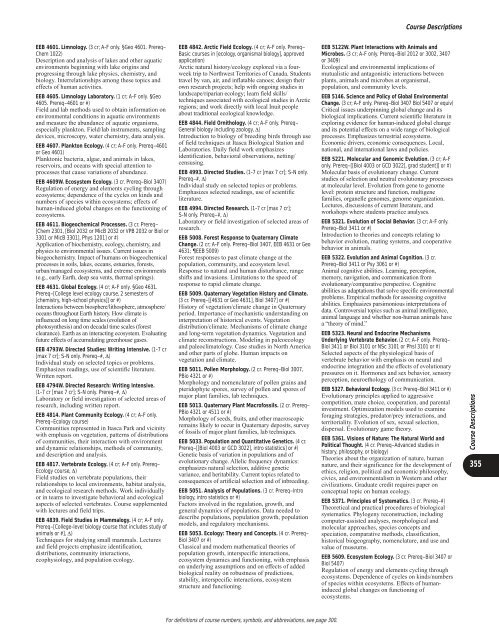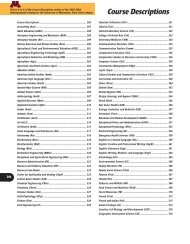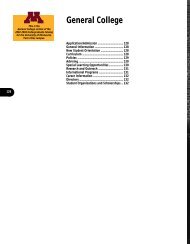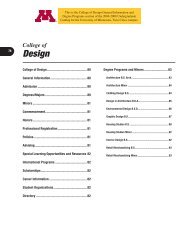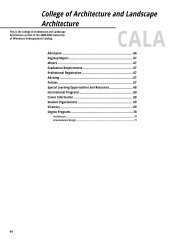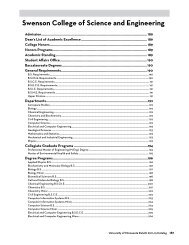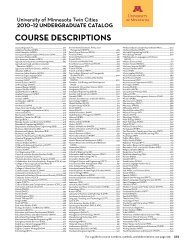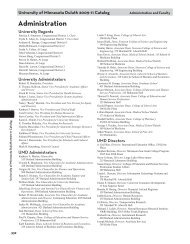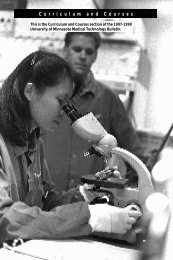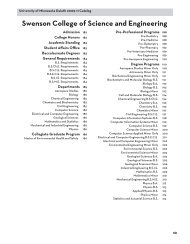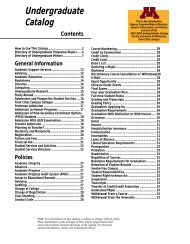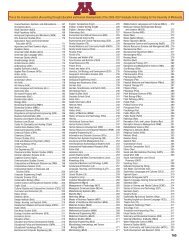CoursesâCSCI through FSCN - University Catalogs - University of ...
CoursesâCSCI through FSCN - University Catalogs - University of ...
CoursesâCSCI through FSCN - University Catalogs - University of ...
Create successful ePaper yourself
Turn your PDF publications into a flip-book with our unique Google optimized e-Paper software.
Course DescriptionsEEB 4601. Limnology. (3 cr; A-F only. §Geo 4601. Prereq–Chem 1022)Description and analysis <strong>of</strong> lakes and other aquaticenvironments beginning with lake origins andprogressing <strong>through</strong> lake physics, chemistry, andbiology. Interrelationships among these topics andeffects <strong>of</strong> human activities.EEB 4605. Limnology Laboratory. (1 cr; A-F only. §Geo4605. Prereq–4601 or #)Field and lab methods used to obtain information onenvironmental conditions in aquatic environmentsand measure the abundance <strong>of</strong> aquatic organisms,especially plankton. Field/lab instruments, samplingdevices, microscopy, water chemistry, data analysis.EEB 4607. Plankton Ecology. (4 cr; A-F only. Prereq–4601or Geo 4601)Planktonic bacteria, algae, and animals in lakes,reservoirs, and oceans with special attention toprocesses that cause variations <strong>of</strong> abundance.EEB 4609W. Ecosystem Ecology. (3 cr. Prereq–Biol 3407)Regulation <strong>of</strong> energy and elements cycling <strong>through</strong>ecosystems; dependence <strong>of</strong> the cycles on kinds andnumbers <strong>of</strong> species within ecosystems; effects <strong>of</strong>human-induced global changes on the functioning <strong>of</strong>ecosystems.EEB 4611. Biogeochemical Processes. (3 cr. Prereq–[Chem 2301, [Biol 2032 or MicB 2032 or VPB 2032 or Biol or3301 or MicB 3301], Phys 1201] or #)Application <strong>of</strong> biochemistry, ecology, chemistry, andphysics to environmental issues. Current issues inbiogeochemistry. Impact <strong>of</strong> humans on biogeochemicalprocesses in soils, lakes, oceans, estuaries, forests,urban/managed ecosystems, and extreme environments(e.g., early Earth, deep sea vents, thermal springs).EEB 4631. Global Ecology. (4 cr; A-F only. §Geo 4631.Prereq–[College level ecology course, 2 semesters <strong>of</strong>[chemistry, high-school physics]] or #)Interactions between biosphere/lithosphere, atmosphere/oceans <strong>through</strong>out Earth history. How climate isinfluenced on long time scales (evolution <strong>of</strong>photosynthesis) and on decadal time scales (forestclearance). Earth as an interacting ecosystem. Evaluatingfuture effects <strong>of</strong> accumulating greenhouse gases.EEB 4793W. Directed Studies: Writing Intensive. (1-7 cr[max 7 cr]; S-N only. Prereq–#, ∆)Individual study on selected topics or problems.Emphasizes readings, use <strong>of</strong> scientific literature.Written report.EEB 4794W. Directed Research: Writing Intensive.(1-7 cr [max 7 cr]; S-N only. Prereq–#, ∆)Laboratory or field investigation <strong>of</strong> selected areas <strong>of</strong>research, including written report.EEB 4814. Plant Community Ecology. (4 cr; A-F only.Prereq–Ecology course)Communities represented in Itasca Park and vicinitywith emphasis on vegetation, patterns <strong>of</strong> distributions<strong>of</strong> communities, their interaction with environmentand dynamic relationships, methods <strong>of</strong> community,and description and analysis.EEB 4817. Vertebrate Ecology. (4 cr; A-F only. Prereq–Ecology course, ∆)Field studies on vertebrate populations, theirrelationships to local environments, habitat analysis,and ecological research methods. Work individuallyor in teams to investigate behavioral and ecologicalaspects <strong>of</strong> selected vertebrates. Course supplementedwith lectures and field trips.EEB 4839. Field Studies in Mammalogy. (4 cr; A-F only.Prereq–[College-level biology course that includes study <strong>of</strong>animals or #], ∆)Techniques for studying small mammals. Lecturesand field projects emphasize identification,distributions, community interactions,ecophysiology, and population ecology.EEB 4842. Arctic Field Ecology. (4 cr; A-F only. Prereq–Basic courses in [ecology, organismal biology], approvedapplication)Arctic natural history/ecology explored via a fourweektrip to Northwest Territories <strong>of</strong> Canada. Studentstravel by van, air, and inflatable canoes; design theirown research projects; help with ongoing studies inlandscape/riparian ecology; learn field skills/techniques associated with ecological studies in Arcticregions; and work directly with local Inuit peopleabout traditional ecological knowledge.EEB 4844. Field Ornithology. (4 cr; A-F only. Prereq–General biology including zoology, ∆)Introduction to biology <strong>of</strong> breeding birds <strong>through</strong> use<strong>of</strong> field techniques at Itasca Biological Station andLaboratories. Daily field work emphasizesidentification, behavioral observations, netting/censusing.EEB 4993. Directed Studies. (1-7 cr [max 7 cr]; S-N only.Prereq–#, ∆)Individual study on selected topics or problems.Emphasizes selected readings, use <strong>of</strong> scientificliterature.EEB 4994. Directed Research. (1-7 cr [max 7 cr];S-N only. Prereq–#, ∆)Laboratory or field investigation <strong>of</strong> selected areas <strong>of</strong>research.EEB 5008. Forest Response to Quaternary ClimateChange. (2 cr; A-F only. Prereq–Biol 3407, EEB 4631 or Geo4631; EEB 5009)Forest responses to past climate change at thepopulation, community, and ecosystem level.Response to natural and human disturbance, rangeshifts and invasions. Limitations to the speed <strong>of</strong>response to rapid climate change.EEB 5009. Quaternary Vegetation History and Climate.(3 cr. Prereq–[[4631 or Geo 4631], Biol 3407] or #)History <strong>of</strong> vegetation/climate change in Quaternaryperiod. Importance <strong>of</strong> mechanistic understanding oninterpretation <strong>of</strong> historical events. Vegetationdistribution/climate. Mechanisms <strong>of</strong> climate changeand long-term vegetation dynamics. Vegetation andclimate reconstructions. Modeling in paleoecologyand paleoclimatology. Case studies in North Americaand other parts <strong>of</strong> globe. Human impacts onvegetation and climate.EEB 5011. Pollen Morphology. (2 cr. Prereq–Biol 3007,PBio 4321 or #)Morphology and nomenclature <strong>of</strong> pollen grains andpteridophyte spores, survey <strong>of</strong> pollen and spores <strong>of</strong>major plant families, lab techniques.EEB 5013. Quaternary Plant Macr<strong>of</strong>ossils. (2 cr. Prereq–PBio 4321 or 4511 or #)Morphology <strong>of</strong> seeds, fruits, and other macroscopicremains likely to occur in Quaternary deposits, survey<strong>of</strong> fossils <strong>of</strong> major plant families, lab techniques.EEB 5033. Population and Quantitative Genetics. (4 cr.Prereq–[[Biol 4003 or GCD 3022], intro statistics] or #)Genetic basis <strong>of</strong> variation in populations and <strong>of</strong>evolutionary change. Allelic frequency dynamics:emphasizes natural selection, additive geneticvariance, and heritability. Current topics related toconsequences <strong>of</strong> artificial selection and <strong>of</strong> inbreeding.EEB 5051. Analysis <strong>of</strong> Populations. (3 cr. Prereq–Introbiology, intro statistics or #)Factors involved in the regulation, growth, andgeneral dynamics <strong>of</strong> populations. Data needed todescribe populations, population growth, populationmodels, and regulatory mechanisms.EEB 5053. Ecology: Theory and Concepts. (4 cr. Prereq–Biol 3407 or #)Classical and modern mathematical theories <strong>of</strong>population growth, interspecific interactions,ecosystem dynamics and functioning, with emphasison underlying assumptions and on effects <strong>of</strong> addedbiological reality on robustness <strong>of</strong> predictions,stability, interspecific interactions, ecosystemstructure and functioning.EEB 5122W. Plant Interactions with Animals andMicrobes. (3 cr; A-F only. Prereq–Biol 2012 or 3002, 3407or 3409)Ecological and environmental implications <strong>of</strong>mutualistic and antagonistic interactions betweenplants, animals and microbes at organismal,population, and community levels.EEB 5146. Science and Policy <strong>of</strong> Global EnvironmentalChange. (3 cr; A-F only. Prereq–Biol 3407 Biol 5407 or equiv)Critical issues underpinning global change and itsbiological implications. Current scientific literature inexploring evidence for human-induced global changeand its potential effects on a wide range <strong>of</strong> biologicalprocesses. Emphasizes terrestrial ecosystems.Economic drivers, economic consequences. Local,national, and international laws and policies.EEB 5221. Molecular and Genomic Evolution. (3 cr; A-Fonly. Prereq–[[Biol 4003 or GCD 3022], grad student]] or #)Molecular basis <strong>of</strong> evolutionary change. Currentstudies <strong>of</strong> selection and neutral evolutionary processesat molecular level. Evolution from gene to genomelevel: protein structure and function, multigenefamilies, organelle genomes, genome organization.Lectures, discussions <strong>of</strong> current literature, andworkshops where students practice analyses.EEB 5321. Evolution <strong>of</strong> Social Behavior. (3 cr; A-F only.Prereq–Biol 3411 or #)Introduction to theories and concepts relating tobehavior evolution, mating systems, and cooperativebehavior in animals.EEB 5322. Evolution and Animal Cognition. (3 cr.Prereq–Biol 3411 or Psy 3061 or #)Animal cognitive abilities. Learning, perception,memory, navigation, and communication fromevolutionary/comparative perspective. Cognitiveabilities as adaptations that solve specific environmentalproblems. Empirical methods for assessing cognitiveabilities. Emphasizes parsimonious interpretations <strong>of</strong>data. Controversial topics such as animal intelligence,animal language and whether non-human animals havea “theory <strong>of</strong> mind.”EEB 5323. Neural and Endocrine MechanismsUnderlying Vertebrate Behavior. (2 cr; A-F only. Prereq–Biol 3411 or Biol 3101 or NSc 3101 or Phsl 3101 or #)Selected aspects <strong>of</strong> the physiological basis <strong>of</strong>vertebrate behavior with emphasis on neural andendocrine integration and the effects <strong>of</strong> evolutionarypressures on it. Hormones and sex behavior, sensoryperception, neuroethology <strong>of</strong> communication.EEB 5327. Behavioral Ecology. (3 cr. Prereq–Biol 3411 or #)Evolutionary principles applied to aggressivecompetition, mate choice, cooperation, and parentalinvestment. Optimization models used to examineforaging strategies, predator/prey interactions, andterritoriality. Evolution <strong>of</strong> sex, sexual selection,dispersal. Evolutionary game theory.EEB 5361. Visions <strong>of</strong> Nature: The Natural World andPolitical Thought. (4 cr. Prereq–Advanced studies inhistory, philosophy, or biology)Theories about the organization <strong>of</strong> nature, humannature, and their significance for the development <strong>of</strong>ethics, religion, political and economic philosophy,civics, and environmentalism in Western and othercivilizations. Graduate credit requires paper onconceptual topic on human ecology.EEB 5371. Principles <strong>of</strong> Systematics. (3 cr. Prereq–#)Theoretical and practical procedures <strong>of</strong> biologicalsystematics. Phylogeny reconstruction, includingcomputer-assisted analyses, morphological andmolecular approaches, species concepts andspeciation, comparative methods, classification,historical biogeography, nomenclature, and use andvalue <strong>of</strong> museums.EEB 5609. Ecosystem Ecology. (3 cr. Prereq–Biol 3407 orBiol 5407)Regulation <strong>of</strong> energy and elements cycling <strong>through</strong>ecosystems. Dependence <strong>of</strong> cycles on kinds/numbers<strong>of</strong> species within ecosystems. Effects <strong>of</strong> humaninducedglobal changes on functioning <strong>of</strong>ecosystems.Course Descriptions355For definitions <strong>of</strong> course numbers, symbols, and abbreviations, see page 300.


